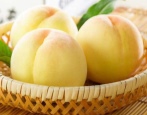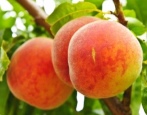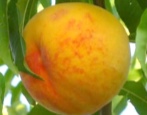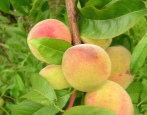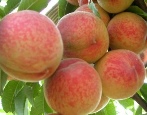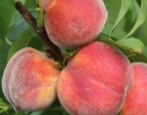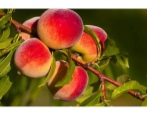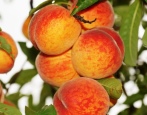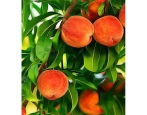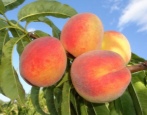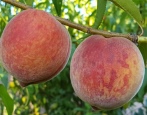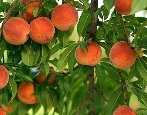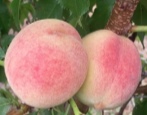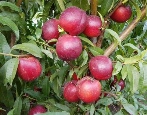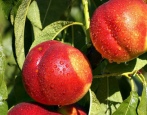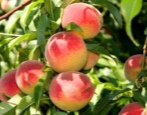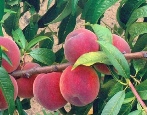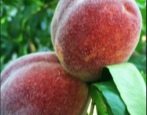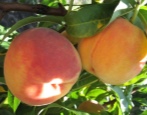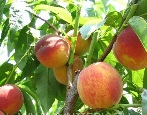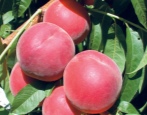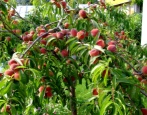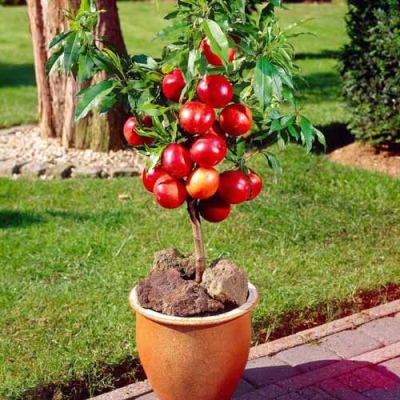
- Authors: Nikitsky Botanical Garden
- Growth type: undersized
- Ripening period: early maturing
- Self-fertility: self-fertile
- Appointment: for canning
- Yield: high
- Early maturity: begins to bear fruit in the 2-3rd year after planting
- Separability of the bone from the pulp: good
- Winter hardiness: medium
- Disease and pest resistance: stable
Columnar nectarine variety Rubis was bred in Nikitsky Botanical Garden. This variety is ideally suited to the needs of those who like to explore new crops. The columnar compact crown allows you to grow it even where stone fruits are seen only in pictures. It can be placed in a greenhouse, winter garden, even in an ordinary apartment.
Description of the variety
A low columnar tree up to 1.7 m, often grows up to 1.2-1.5 m. The crown is up to 50 cm in diameter, with shoots tightly adhering to the trunk. The leaves are narrow, long, bright green. It blooms early, the flowers are large, beautiful, pink, very decorative, have a pleasant aroma. The growth rate is average, in the first 2 years it grows slowly.
Fruit characteristics
Fruits for nectarine are large, reaching the size of medium peaches - 140-160 g. According to some sources, the fruits can be up to 250 g. The skin is smooth, with a slight gloss, bright yellow in color with a thick burgundy tan. The pulp is golden. The bone is easily separated from the pulp.
Taste qualities
The taste is sweet, pleasant, the pulp is very aromatic. The fruits are mainly intended for canning.
Ripening and fruiting
The Rubis variety is early maturing, the first fruits begin to take off at the end of July.
Yield
The yield is high, an average of 7-8 kg is removed from 1 tree. A fast-growing, full-fledged harvest can be obtained in the 2-3rd year after planting. The productive period is short, like all columnar varieties. Plants age faster and need to be updated earlier in comparison with classic varieties.
Self-fertility and the need for pollinators
The variety is completely self-fertile. If you wish, you can plant 1 copy at home in a pot or container - the fruits will still be there.
Growing and care
The seedlings are sold with a packed root system, they can be planted in the fall, or they can be stored until spring at a temperature of + 2 ... 3 ° C. In spring, Rubis nectarine is planted in fertile, loose soil in a bright, well protected place from the winds. The soil must be well drained. All apricots, peaches and nectarines cannot stand stagnant moisture. Rubis is no exception. Therefore, you should not plant a plant in places where groundwater is close, in lowlands, where cold air or moisture flows in spring. Soil PH is neutral, above 6.5.
A landing pit for Rubis nectarine is prepared in advance with a depth of 40 cm and a width of 50 cm. The acidic soil is deacidified, and half a bucket of humus is poured onto the bottom of the pit, 1 glass of ash and 1 tbsp. l. superphosphate, thoroughly loosened and give the soil a rest for 2 weeks. After that, a young tree is planted, tying it to a peg.
If planting is carried out in a container, its volume must be at least 30 liters.
The Rubis variety does not need pruning, since the branches do not form lateral shoots, and the fruits are located very close to the crown. However, in the first year, all flowers are removed so that the plant does not undergo depletion. The task of the first year is the growth of the tree itself. In the second year, the flowers are partially thinned out, especially if it is important to get the largest possible fruits.
Fertilize the culture 3-4 times per season. In the spring, nitrogen fertilization is needed; closer to fruiting, complex mineral fertilizers with a good potassium content are used. In autumn, phosphate fertilizers are applied in special grooves up to 15 cm deep, at a distance of 25 cm from the tree.
Watering is needed abundant and attentive, especially in spring, especially in the first year of life. By the end of summer, watering is reduced, gradually adjusting the plant to prepare for winter. After watering, the soil is loosened, then mulched.
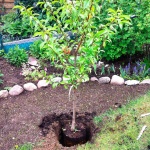
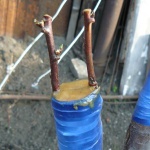
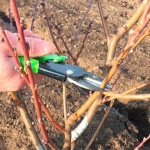
Frost resistance and the need for shelter
The winter hardiness of the crop is average. The plant is covered for the winter. In the first years after planting, it is better to carry out a full-fledged shelter under the frame, then it is enough to wind the barrel with any porous insulating material and mulch the trunk circle. The trunk can be wrapped with burlap, spruce branches, corn stalks. Before the shelter, if the autumn is dry, abundant water-charging irrigation is carried out, the stem is whitewashed, dry and damaged branches are removed, if any, the soil is loosened, slightly digging it up with mullein and peat.
Disease and pest resistance
The variety is resistant to moniliosis, curliness, powdery mildew. However, if the spring is damp and cold, the risk of getting sick increases. Treatments with copper-containing preparations (before the leaves and flowers dissolve), "Fitosporin" (at any time of the year) will be useful. Supporters of natural remedies will love spraying with onion peel or orange peel decoction. A little green soap is added to the mixture so that it lingers on the leaves. In the fall, the site must be carefully cleaned, all fallen leaves or fruits are removed from the soil. Mulch should only be done with fresh materials.
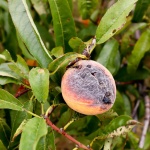
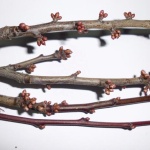
Review overview
Nectarine Rubis is a novelty on the market. There are few reviews yet, but it is of interest. The tree is small, but very effective. For a dwarf plant, it has excellent performance. Good fruit taste, fairly high yield and unpretentiousness.
